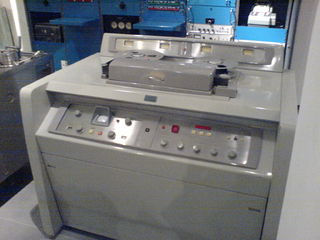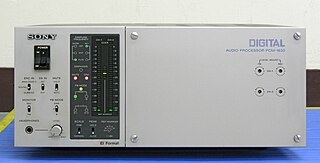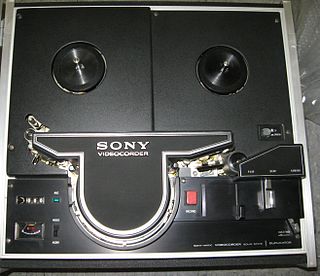
The VHS is a standard for consumer-level analog video recording on tape cassettes, invented in 1976 by the Victor Company of Japan (JVC). It was the dominant home video format throughout the tape media period in the 1980s and 1990s.

Videotape is magnetic tape used for storing video and usually sound in addition. Information stored can be in the form of either an analog or digital signal. Videotape is used in both video tape recorders (VTRs) and, more commonly, videocassette recorders (VCRs) and camcorders. Videotapes have also been used for storing scientific or medical data, such as the data produced by an electrocardiogram.

S-VHS (スーパー・ヴィエイチエス), the common initialism for Super VHS, is an improved version of the VHS standard for consumer-level video recording. Victor Company of Japan introduced S-VHS in Japan in April 1987, with their JVC-branded HR-S7000 VCR, and in certain overseas markets soon afterward. By the end of 1987, the first S-VHS VCR models from other competitors included Hitachi VT-2700A, Mitsubishi HS-423UR, Panasonic PV-S4764, RCA VPT-695HF, and Toshiba SV-950. It has been standardized as IEC 60774-3 and IEC 60774-4.

Betamax is a consumer-level analog recording and cassette format of magnetic tape for video, commonly known as a video cassette recorder. It was developed by Sony and was released in Japan on May 10, 1975, followed by the US in November of the same year.

Digital8 is a consumer digital recording videocassette for camcorders developed by Sony, and introduced in 1999. It is technically identical to DV cassettes, but uses physical Hi8 tapes instead.

A camcorder is a self-contained portable electronic device with video and recording as its primary function. It is typically equipped with an articulating screen mounted on the left side, a belt to facilitate holding on the right side, hot-swappable battery facing towards the user, hot-swappable recording media, and an internally contained quiet optical zoom lens.
Betacam is a family of half-inch professional videocassette products developed by Sony in 1982. In colloquial use, Betacam singly is often used to refer to a Betacam camcorder, a Betacam tape, a Betacam video recorder or the format itself.

A video tape recorder (VTR) is a tape recorder designed to record and playback video and audio material from magnetic tape. The early VTRs were open-reel devices that record on individual reels of 2-inch-wide (5.08 cm) tape. They were used in television studios, serving as a replacement for motion picture film stock and making recording for television applications cheaper and quicker. Beginning in 1963, videotape machines made instant replay during televised sporting events possible. Improved formats, in which the tape was contained inside a videocassette, were introduced around 1969; the machines which play them are called videocassette recorders.

The videotape format war was a period of competition or "format war" of incompatible models of consumer-level analog video videocassette and video cassette recorders (VCR) in the late 1970s and the 1980s, mainly involving the Betamax and Video Home System (VHS) formats. VHS ultimately emerged as the preeminent format.

The 8mm video format refers informally to three related videocassette formats. These are the original Video8 format and its improved successor Hi8, as well as a more recent digital recording format known as Digital8. Their user base consisted mainly of amateur camcorder users, although they also saw important use in the professional television production field.

MicroMV is a proprietary videotape format introduced in October 2001 by Sony. It is the smallest videotape format — 70% smaller than MiniDV or about the size of two US quarter coins; it is also smaller than a Digital8 or DV cassette and slightly smaller than an audio microcassette. It was the first helical scan tape system using MR read head introduced to the market. Each cassette can hold up to 60 minutes of video.

VHS-C is the compact variant of the VHS videocassette format, introduced by Victor Company of Japan (JVC) in 1982, and used primarily for consumer-grade compact analog recording camcorders. The format is based on the same video tape as is used in VHS, and can be played back in a standard VHS VCR with an adapter. An improved version named S-VHS-C was also developed. S-VHS's main competitor was Video8; however both became obsolete in the marketplace by the digital video formats MiniDV and MiniDVD, which have smaller form factors.

U-matic or 3⁄4-inch Type E Helical Scan or SMPTE E is an analogue recording videocassette format first shown by Sony in prototype in October 1969, and introduced to the market in September 1971. It was among the first video formats to contain the videotape inside a cassette, as opposed to the various reel-to-reel or open-reel formats of the time. The videotape is 3⁄4 in (19 mm) wide, so the format is often known as "three-quarter-inch" or simply "three-quarter", compared to open reel videotape formats in use, such as 1 in (25 mm) type C videotape and 2 in (51 mm) quadruplex videotape.

A PCM adaptor is a device that encodes digital audio as video for recording on a videocassette recorder. The adapter also has the ability to decode a video signal back to digital audio for playback. This digital audio system was used for mastering early compact discs.

The JVC GR-C1 VideoMovie was a camcorder released in March 1984 by JVC. It was notable as the second consumer-grade all-in-one camcorder after 1983 Sony Betamovie, as opposed to earlier portable systems in which the camera and recorder were separate units linked by a cable, and as the first VHS-C camcorder.

The 1/4 inch Akai is a portable helical scan EIA and CCIR analog recording video tape recorder (VTR) with two video record heads on the scanning drum. The units were available with an optional RF modulator to play back through a TV set, as well as a detachable video monitor. The Akai Electric Ltd. VTR plant was in Tokyo, Japan.

Compact Video Cassette (CVC) was one of the first analog recording videocassette formats to use a tape smaller than its earlier predecessors of VHS and Betamax, and was developed by Funai Electronics of Japan for portable use. The first model of VCR for the format was the Model 212, introduced in 1980 by both Funai and Technicolor as they had created a joint venture to manufacture and introduce the format to the home movie market. The system, which included the VCR and a hand held video camera, was very small and lightweight for its time.

EIAJ-1 was a standard for video tape recorders (VTRs) developed by the Electronic Industries Association of Japan with the cooperation and assistance of several Japanese electronics manufacturers in 1969. It was the first standardized format for industrial/non-broadcast VTRs using a helical scan system employing open reel tape. Previously, each manufacturer of machines in this market used a different proprietary format, with differing tape speeds, scanner drum diameters, bias frequencies, tracking head placement, and so on, although most used 1/2" wide tape. As a result, video tapes recorded on one make and/or model of VTR could only be interchanged with other machines using that specific format, hampering compatibility. For example, a reel of tape recorded on a Panasonic machine would not play on a Sony machine, and vice versa. The EIAJ-1 standard ended this incompatibility, giving those manufacturers a standardized format, interchangeable with almost all VTRs subsequently brought to market around that time. The format offered black-and-white video recording and playback on 1/2″ magnetic tape on a 7″ diameter open reel, with portable units using smaller 5″ diameter reels.
VK is a helical scan analog recording videocassette format developed by Akai in the late 1970s, that is capable of recording and playing back black & white video in either EIA and CCIR systems.

A videocassette recorder (VCR) or video recorder is an electromechanical device that records analog audio and analog video from broadcast television or other AV sources and can play back the recording after rewinding. The use of a VCR to record a television program to play back at a more convenient time is commonly referred to as time shifting. VCRs can also play back prerecorded tapes, which were widely available for purchase and rental starting in the 80s and 90s, most popularly in the VHS videocassette format. Blank tapes were sold to make recordings.























